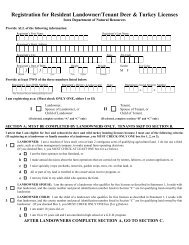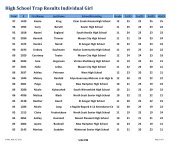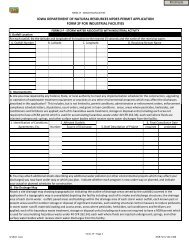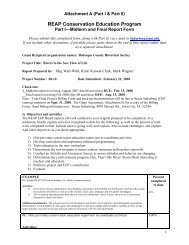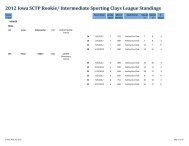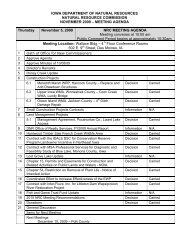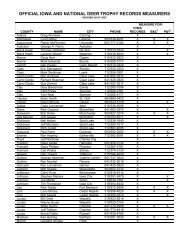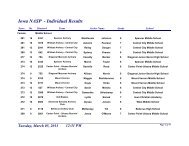3 Dams and River Ecology - Iowa Department of Natural Resources
3 Dams and River Ecology - Iowa Department of Natural Resources
3 Dams and River Ecology - Iowa Department of Natural Resources
You also want an ePaper? Increase the reach of your titles
YUMPU automatically turns print PDFs into web optimized ePapers that Google loves.
XW<br />
XW<br />
XW<br />
XW<br />
Excessive zebra mussel colonization <strong>of</strong> native mussels<br />
can lead to mortality among native mussels. However,<br />
unlike native mussels which colonize upriver by using fish<br />
hosts, exotic zebra mussels produce immense quantities<br />
<strong>of</strong> young, waterbourne zebra mussels called “veligers” that<br />
can quickly spread throughout lakes <strong>and</strong> impoundments.<br />
These veligers can also drift down rivers. Swifter water may<br />
help destroy the veligers as they move downstream, while<br />
impoundments provide locations where it is more likely<br />
veligers may drop out <strong>of</strong> the water column <strong>and</strong> begin<br />
colonies.<br />
XW<br />
XW<br />
Elk Creek<br />
XW XW<br />
XW<br />
XW<br />
XW<br />
XWXWXWXWXW<br />
XW<br />
XW<br />
XW<br />
XW<br />
XW<br />
XW<br />
XW<br />
XW<br />
XW<br />
XW<br />
XW<br />
Rock Creek<br />
XWXW<br />
XW<br />
XW<br />
XW<br />
XW<br />
XW<br />
XW<br />
XW<br />
XWXW<br />
XW<br />
XW<br />
Beaver Creek<br />
XW<br />
XW<br />
XW<br />
XW<br />
XW<br />
Little Wapsipinicon <strong>River</strong><br />
XWXW<br />
XW<br />
XW<br />
XW<br />
XWXW<br />
XW<br />
XW<br />
XW<br />
XW<br />
Crane Creek<br />
XW<br />
XW<br />
XW<br />
XW<br />
XWXW<br />
XW<br />
XW<br />
XWXW<br />
XW<br />
XW<br />
XW<br />
XW<br />
XW<br />
XW<br />
XW<br />
XW<br />
XW<br />
XW<br />
XW<br />
XW<br />
XW<br />
XWXW<br />
XW<br />
XW<br />
Currently in the interior <strong>of</strong> <strong>Iowa</strong>, zebra mussels are known<br />
to infest one natural lake, Clear Lake, <strong>and</strong> one river<br />
impoundment, Lake Delhi. Water from Clear Lake feeds<br />
Willow Creek, which flows into the Winnebago <strong>River</strong>, which<br />
flows into the Shell Rock <strong>River</strong>, which flows into the Cedar<br />
<strong>River</strong> <strong>and</strong> eventually the <strong>Iowa</strong>. Because Willow Creek <strong>and</strong><br />
the Winnebago <strong>River</strong> are naturally rapids streams, it may<br />
be that removal <strong>of</strong> several unused dams, if there is little<br />
social value to the dams, could have positive benefits on<br />
slowing the downriver spread <strong>of</strong> zebra mussels.<br />
Fig. 5-6 <strong>River</strong> Segments to Monitor For Dowstream Spread <strong>of</strong> Zebra Mussel<br />
<strong>Iowa</strong> <strong>River</strong><br />
Wor-1<br />
Legend<br />
XW<br />
XW<br />
Figure 3-f examines impoundments downstream <strong>of</strong> the two zebra-mussel infested waters in <strong>Iowa</strong>’s interior, for potential<br />
overlapping priorities. Where dam projects otherwise have movements, removal will be encouraged as a preferred option<br />
to potentially reduce downstream spread <strong>of</strong> zebra mussels.<br />
Har-1<br />
Willow Creek<br />
Shell Rock <strong>River</strong><br />
Winnebago <strong>River</strong><br />
Har-2<br />
Fish barrier<br />
Wor-2<br />
Beaverdam Creek<br />
Fra-3<br />
Fra-1<br />
Fra-2<br />
Cer-5<br />
Cer-19<br />
Cer-9<br />
Cer-10<br />
South Fork <strong>Iowa</strong> <strong>River</strong><br />
<strong>Iowa</strong> <strong>River</strong><br />
Hartgrave Creek<br />
Har-3<br />
Flo-3<br />
Mit-2<br />
Mit-5<br />
Cedar <strong>River</strong><br />
Mit-8 Flo-6<br />
Black Hawk Creek<br />
Cedar <strong>River</strong><br />
Shell Rock <strong>River</strong><br />
Impoundments likely to be colonized by zebra mussels<br />
Mississippi Lock & <strong>Dams</strong><br />
Fish segments<br />
Major Lakes<br />
County Boundary<br />
Mit-3<br />
Mit-7<br />
Flo-4<br />
Mit-4<br />
Flo-5<br />
But-1<br />
Mit-1<br />
But-5<br />
Gru-3<br />
Flo-1<br />
But-3<br />
Flo-2<br />
But-4<br />
How-2<br />
Chi-2<br />
Chi-3<br />
Cedar <strong>River</strong><br />
How-6<br />
Bre-2<br />
Bla-1 Bla-2<br />
Bla-5<br />
Crane Creek Crane Creek<br />
Chi-4<br />
Bla-3<br />
Chi-1<br />
Bla-4<br />
Bre-1<br />
How-3<br />
How-1<br />
How-4<br />
Fay-9<br />
Buc-1<br />
Buc-2<br />
Otter Creek<br />
Win-3<br />
Fay-8<br />
Fay-2<br />
Fay-7<br />
Buc-6<br />
Buc-4<br />
Buc-3<br />
Cedar <strong>River</strong><br />
Win-2<br />
Win-1<br />
Buc-5<br />
Volga <strong>River</strong><br />
Buffalo Creek<br />
Wapsipinicon <strong>River</strong><br />
Lin-5<br />
Fay-4<br />
Lin-3<br />
Del-1<br />
Del-2<br />
Lin-7<br />
Lin-6<br />
Cly-1<br />
Del-3<br />
Upper <strong>Iowa</strong> <strong>River</strong><br />
Yellow <strong>River</strong><br />
Cly-2<br />
Del-4<br />
Buffalo Creek<br />
Del-5<br />
XW<br />
Jon-1<br />
XW XW<br />
XW<br />
XW<br />
Turkey <strong>River</strong><br />
All-1 All-1<br />
Jon-3<br />
Cly-4<br />
Turkey <strong>River</strong><br />
XW<br />
Dub-2<br />
Wapsipinicon <strong>River</strong><br />
Maquoketa <strong>River</strong><br />
XW<br />
Jon-2<br />
XW<br />
Cer-19<br />
Lytle Creek<br />
Jac-3<br />
XW<br />
XW<br />
XW<br />
XW<br />
XW<br />
Dub-3<br />
Jac-1<br />
Jac-2<br />
Willow Creek<br />
Maquoketa <strong>River</strong><br />
Jac-4<br />
XW<br />
Cer-9<br />
XW<br />
XW<br />
Cer-11<br />
XW<br />
Cer-8<br />
Winnebago <strong>River</strong><br />
XW<br />
XW XW<br />
Cer-5<br />
Cer-6<br />
Cer-7<br />
Cer-18 Cer-13<br />
Willow Creek <strong>Dams</strong> to Confluence<br />
39<br />
Legend<br />
XW<br />
XW<br />
Fish barrier<br />
Fish segments<br />
Major Lakes<br />
County Boundary<br />
Lake Delhi was an impoundment on the Maquoketa <strong>River</strong><br />
that was heavily infested with zebra mussels prior to its<br />
breach in 2010 (see image below). A dam directly downstream,<br />
Mon-Maq Dam, is currently undergoing alternative<br />
analysis in a community effort, due to flooding problems<br />
that may in part be caused by the dam <strong>and</strong> an associated<br />
dike. While it is unlikely the zebra mussel issue will become<br />
a primary local driver to drive outcomes such as thes dams,<br />
considering ways to slow the speared <strong>of</strong> zebra mussels<br />
should be considered.<br />
Actions<br />
1) Where dams with little remaining social value<br />
coincide with zebra mussel priorities, high biological<br />
priority shall be given to removal <strong>of</strong> structures <strong>and</strong><br />
restoration <strong>of</strong> free-flowing water.<br />
2) Collaborations among USFWS, DNR aquatic invansive<br />
species program, <strong>and</strong> <strong>Iowa</strong> DNR 319 program will<br />
be sought in support <strong>of</strong> such projects.<br />
3) Where dams are failing, ensure the public is presented<br />
with a full range <strong>of</strong> alternatives that include<br />
biological connectivity.<br />
Zebra mussels blanketed all hard surfaces beneath<br />
Lake Delhi, including the dam before the July breach.



